Newton's laws - the laws that changed the world - Second law
Greetings friends, continuing to speak of the laws of Newton, in my publication of the first part, talk about the history, the theoretical foundations of the laws and the first law of Newton or law of inertia as well as reference to the application of this law, today giving continuity to this issue, I will explain the second law of Newton or fundamental law of the dynamics and the applications of said law.

Isaac newton ( 1642- 1727)
Newton's second law states that:
the change of movement is directly proportional to the printed driving force and occurs along the straight line along which that force prints.
This law is responsible for quantifying the concept of force. The acceleration that a body acquires is proportional to the net force applied to it. The constant of proportionality is the mass of the body (which may or may not be constant). Understanding the force as the cause of the change of movement and the proportionality between the printed force and the change of the speed of a body is the essence of this second law.
If the mass is constant
If the mass of the body is constant, we can establish the following relation that constitutes the fundamental equation of the dynamics:

Where m is the mass of the body which must be constant to be expressed in such a way. The net force acting on a body, also called the resultant force, is the sum vector of all the forces acting on it. So that :

The acceleration that a body acquires is proportional to the applied force, and the constant of proportionality is the mass of the body.
If several forces act, this equation refers to the resultant force, vector sum of all of them.
This is a vector equation, then it must be fulfilled component by component.
Sometimes it is useful to remember the concept of intrinsic components if the trajectory is not straight is because there is a normal acceleration, then there will be a normal force (in a direction perpendicular to the trajectory) if the modulus of the speed varies because there is an acceleration in the direction of the speed (in the same direction of the trajectory).
Force and acceleration are parallel vectors, but this does not mean that the velocity vector is parallel to the force. That is to say, the trajectory does not have to be tangent to the applied force (only happens if at least, the direction of the speed is constant).
This equation must be fulfilled for all bodies. When we analyze a problem with several bodies and different forces applied to them, we must then take into account the forces that act on each of them and the principle of superposition of forces. We will apply the second law of Newton for each one of them, taking into account the mutual interactions and obtaining the resultant force on each of them.
The principle of superposition states that if several forces act equally or simultaneously on a body, the resulting force is equal to the vector sum of the forces that act independently on the body (rule of para-realism). This principle is included in the principles of Newton as a colorar, after the third law, but it is an indispensable requirement for the understanding and application of laws, as well as for the vectorial characterization of forces. The force will modify the state of movement, changing the speed in module or direction: The forces are causes that produce accelerations in the bodies. Therefore there is a cause-effect relationship between the applied force and the acceleration that the body is experiencing.
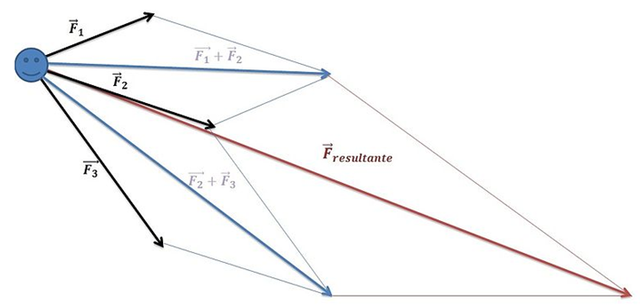
representation of the sum of the forces. Here the force No. 2 is being added twice. The resultant (marked with red) responds to the following equation:
In this way we obtain the unit of measurement of force in the International system of units, the newton:

On the other hand, if the resulting force acting on a particle is not zero, this particle will have an acceleration proportional to the magnitude of the resultant and in the direction of it (because the mass is always a positive scalar). The previous expression thus established is valid both for classical mechanics and for relativistic mechanics.
If the mass is not constant
If the mass of the bodies varies, such as a rocket burning fuel, the relationship F = ma is not valid and the law must be made generic to include the case of systems in which the mass can vary. To do this, we must first define a new physical quantity, the amount of movement that is represented by the letter p and that is defined as the product of the mass of a body by its speed, that is:

Newton listed his law in a more general way:

In this way, force can be related to acceleration and mass, regardless of whether it is constant or not. When the mass is constant it leaves the derivative with what remains the expression:

And you get the classic expression of Newton's second law:

Force, therefore, is a mathematical concept which, by definition, is equal to the derivative with respect to the time of the moment of a given particle, whose value in turn depends on its interaction with other particles. Therefore, force can be considered as the expression of an interaction. Another consequence of expressing Newton's Second Law using the amount of movement is what is known as the conservation principle of momentum: if the total force acting on a body is zero, Newton's Second Law tells us that

That is, the derivative of the momentum with respect to time is zero in its three components. This means that the amount of movement must be constant in time in module direction and direction (the derivative of a constant vector is zero).
Newton's second law is valid only in inertial reference systems but even if the reference system is non-inertial, the same equation can be used including the fictitious forces (or inertial forces). Units and dimensions of the force:
S.i Units: 
Cegesimal system: dine
Equivalence : 
Amount of movement or linear moment
In modern language, the amount of movement or linear momentum of an object is defined by the expression p= mv .That is, it is a vectorial quantity proportional to the mass and the velocity of the object. Starting from this definition and applying the fundamental law of Newtonian mechanics, the variations in the amount of movement are expressed as a function of the resultant force and the time interval during which it is exerted:
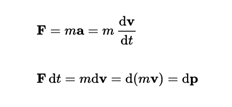
Taking the time interval from t1 to t2 and integrating you get

Vector I is called a linear impulse and represents a physical quantity that manifests itself especially in quick actions or impacts, such as shocks, leading module direction and direction. In this type of action it is convenient to consider the duration of the impact and the force exerted during it.
From the expression obtained it is deduced that the linear impulse is equal to the variation of the momentum. If the resultant force is zero (that is, if the object is not acted upon) the impulse is also zero and the momentum remains constant. We call this statement the conservation law of the linear impulse, applied to an object or a particle.
Its units in the International System are kg.m / s
Conservation of the amount of movement
Elastic shock:
the amount of movement and the kinetic energy remain constant. Two particles of different masses that only interact with each other and move with constant and different speeds towards each other. After the shock, the amount of movement and kinetic energy remains constant.
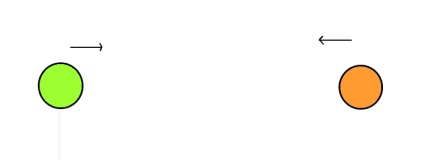
Balls representing elastic shock
Inelastic shock:
the amount of movement remains constant and the kinetic energy varies. As a consequence, the bodies that collide can undergo deformations and increase their temperature. After a totally inelastic shock, both bodies have the same speed. The sum of its kinetic energies is less than the initial because a part of it has been transformed into internal energy; in most cases it becomes dissipated in the form of heat due to the heating produced in the shock. In the ideal case of a perfectly inelastic collision between macroscopic objects, they remain linked together after the collision.

Cars representing inelastic shock
Applications of Newton's second law
Among the possible applications of Newton's Second Law, we can highlight:
Free fall:
is a movement that is observed when an object is dropped from a certain height on the surface of the earth. To study the movement, a coordinate system is chosen where the origin of the y axis is on the latter. In this system both the speed of fall and the acceleration of gravity have a negative sign. In the example shown, it is assumed that the object is dropped from rest, but it may fall from an initial velocity other than zero.
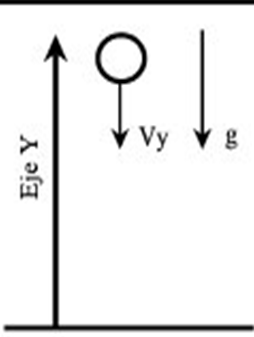
Freefall
Simple pendulum:
particle of mass m suspended from point O by an inextensible thread of length l and of negligible mass. If the particle moves to a position θ0 (angle that makes the thread with the vertical) and then it is released, the pendulum begins to oscillate. The pendulum describes a circular path, an arc of a circle of radius l. The forces acting on the particle of mass m are two, the weight and the tension T of the thread.
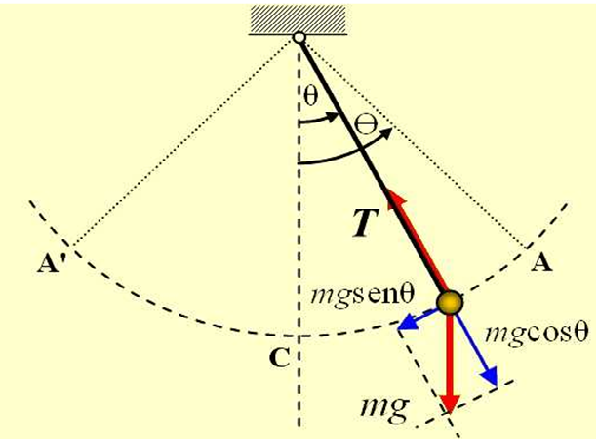
Simple pendulum: Force diagram
If the second law applies, in the radial direction:

where an represents normal acceleration to the trajectory. Once the value of the velocity v in the angular position is known, the thread tension T can be determined. This is maximum when the pendulum goes through the equilibrium position

where the second term represents the centrifugal force.
And the tension is minimal, at the extremes of its trajectory, when the speed is zero

in the tangential direction:

where at represents the acceleration tangent to the trajectory.
Newton's Laws Of Motion (2) : Force, Mass And Acceleration
Source :https://es.wikipedia.org/wiki/Leyes_de_Newton
Bibliography :
Alonso, Marcelo; Finn, Edward J. (1998). Física 1. Madrid.
Bell, Eric T. (1986). On the Seashore: Newton (en inglés).
Christianson, Gale E. (1985). In the Presence of the Creator: Isaac Newton and His Times (en inglés).
Da Costa Andrade, Edward N. (1979). Sir Isaac Newton (en inglés).
De Gandt, François (2014). Force and Geometry in Newton's "Principia" (Princeton Legacy Library) (en inglés).
hello friend @joseferrer, congratulations, as always offering quality content, you have my vote greetings.
thank you friend for your comment always offering quality content, greetings